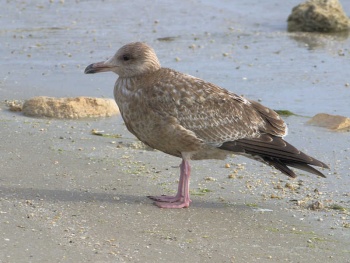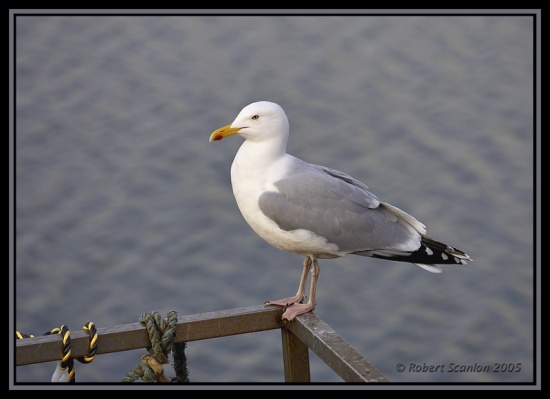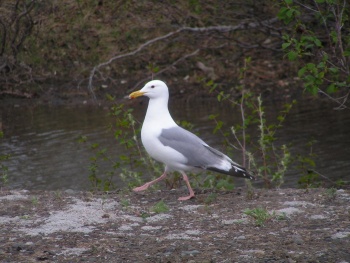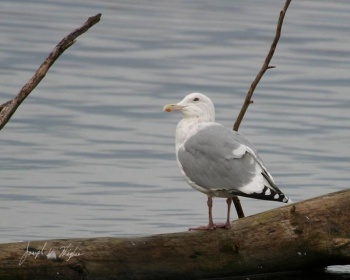(References updated) |
(→References: Updated, expanded and removed dead links.) |
||
| Line 60: | Line 60: | ||
''[[Media:Larus argentatus (song).mp3|Listen in an external program]]'' | ''[[Media:Larus argentatus (song).mp3|Listen in an external program]]'' | ||
==References== | ==References== | ||
| − | #{{Ref- | + | #{{Ref-Clements6thAug18}}#Brazil, M. (2009). Birds of East Asia. Princeton Univ. Press. |
| − | # | + | #Christidis et al. 2014. The Howard and Moore Complete Checklist of the Birds of the World, version 4.1 (Downloadable checklist). Accessed 28 August 2018 from https://www.howardandmoore.org/ |
| − | # | + | #{{Ref-GillDonsker18V8.2}}#Collinson, J.M., Parkin, D.T., Knox, A.G., Sangster, G. & Svensson, L. (2008) Species boundaries in the Herring and Lesser Black-backed Gull complex. ''Brit. Birds'' 101(7): 340–363. |
| + | #Burger, J., Gochfeld, M., Kirwan, G.M., Christie, D.A. & Garcia, E.F.J. (2018). European Herring Gull (''Larus argentatus''). In: del Hoyo, J., Elliott, A., Sargatal, J., Christie, D.A. & de Juana, E. (eds.). Handbook of the Birds of the World Alive. Lynx Edicions, Barcelona. (retrieved from https://www.hbw.com/node/53982 on 27 August 2018). | ||
| + | #Howell, S.N.G. and Dunn, J. (2007) A Reference Guide to the Gulls of the Americas. Peterson Field Guides, New York. | ||
| + | #Malling Olsen, K. & Larsson, H. (2003) Gulls of Europe, Asia and North America. Christopher Helm, London. | ||
| + | #Nisbet, I. C. T., D. V. Weseloh, C. E. Hebert, M. L. Mallory, A. F. Poole, J. C. Ellis, P. Pyle, and M. A. Patten (2017). Herring Gull (''Larus argentatus''), version 3.0. In The Birds of North America (P. G. Rodewald, Editor). Cornell Lab of Ornithology, Ithaca, NY, USA. https://doi.org/10.2173/bna.hergul.03 | ||
| + | #Wikipedia contributors. (2018, July 21). Herring gull. In Wikipedia, The Free Encyclopedia. Retrieved 08:05, August 28, 2018, from https://en.wikipedia.org/w/index.php?title=Herring_gull&oldid=851245816 | ||
{{ref}} | {{ref}} | ||
Revision as of 08:15, 28 August 2018
- Larus argentatus
Includes: Vega Gull and American Herring Gull
Identification
55-66cm. Breeding Adult
- Grey back and upperwings
- White head
- White below
- Black wing tips with white spots
- Bare yellow eye ring
- Yellow bill with red spot
- Pink legs
Non Breeding Adult
- Brown streaks on head and neck
Juvenile
- Brown with dark streaks
- Dark bill
- Dark iris
Second-winter bird
- Whiter head and underparts
- Grey back
Distribution
European Herring Gull
Breeds widely across Northern Europe from Iceland and the Faroes to northern Scandinavia and Arctic Russia, reaching south to the British Isles and France east to Germany, Poland, Belarus and the Baltic States. Has recently been recorded breeding in a Yellow-legged Gull colony in northern Spain.
Mainly resident or dispersive, except in north Norway, the Baltic, Finland and northern Russia where migratory.
Widespread in winter in Western and Central Europe.
Has bred on Svalbard and Bear Island.
Vega Gull
Breeds north-eastern Siberia; winters south to China
American Herring Gull
Breeds from Alaska east across northern Canada to Maritime Provinces, south to British Columbia, north-central Canada, and Great Lakes, and along Atlantic Coast to North Carolina. 1
Taxonomy
Occasionally hybridises with other species, eg Lesser Black-back, and particularly Glaucous Gull in Iceland.
This species also formerly included Yellow-legged Gull, Caspian Gull and Armenian Gull which are now considered full species by most authorities.
Subspecies

Photo by bobsofpa
Sebastian Inlet State Park, Florida, USA, February 2005
Clements[1] and Dickinson actually accept four subspecies in three groups:
- European Herring Gull:
- Vega Gull or East Siberian Gull
- American Herring Gull
- L. a. smithsonianus in northern North America, winters south to Central America
All three groups are accepted as full species by Gill and Donsker.
Habitat
Breeds mainly along rocky coastlines on cliffs, stacks and islands, in some areas on buildings or on flatter areas of shore and in others at inland lakes. Mainly coastal when not breeding but increasingly in urban areas and on farmland. Abundant at refuse-tips and around fishing harbours.
Behaviour
Diet
They are scavengers; they will also take eggs and young birds.
Breeding
They are colony nesters. 2-4 olive eggs are laid on the ground or cliff ledges and are incubated for 28-30 days.
Vocalisation
<flashmp3>Larus argentatus (song).mp3</flashmp3>
Listen in an external program
References
- Clements, J. F., T. S. Schulenberg, M. J. Iliff, D. Roberson, T. A. Fredericks, B. L. Sullivan, and C. L. Wood. 2018. The eBird/Clements checklist of birds of the world: v2018. Downloaded from http://www.birds.cornell.edu/clementschecklist/download/
- Brazil, M. (2009). Birds of East Asia. Princeton Univ. Press.
- Christidis et al. 2014. The Howard and Moore Complete Checklist of the Birds of the World, version 4.1 (Downloadable checklist). Accessed 28 August 2018 from https://www.howardandmoore.org/
- Gill, F & D Donsker (Eds). 2018. IOC World Bird List (v8.2). doi : 10.14344/IOC.ML.8.2. Available at http://www.worldbirdnames.org/
- Collinson, J.M., Parkin, D.T., Knox, A.G., Sangster, G. & Svensson, L. (2008) Species boundaries in the Herring and Lesser Black-backed Gull complex. Brit. Birds 101(7): 340–363.
- Burger, J., Gochfeld, M., Kirwan, G.M., Christie, D.A. & Garcia, E.F.J. (2018). European Herring Gull (Larus argentatus). In: del Hoyo, J., Elliott, A., Sargatal, J., Christie, D.A. & de Juana, E. (eds.). Handbook of the Birds of the World Alive. Lynx Edicions, Barcelona. (retrieved from https://www.hbw.com/node/53982 on 27 August 2018).
- Howell, S.N.G. and Dunn, J. (2007) A Reference Guide to the Gulls of the Americas. Peterson Field Guides, New York.
- Malling Olsen, K. & Larsson, H. (2003) Gulls of Europe, Asia and North America. Christopher Helm, London.
- Nisbet, I. C. T., D. V. Weseloh, C. E. Hebert, M. L. Mallory, A. F. Poole, J. C. Ellis, P. Pyle, and M. A. Patten (2017). Herring Gull (Larus argentatus), version 3.0. In The Birds of North America (P. G. Rodewald, Editor). Cornell Lab of Ornithology, Ithaca, NY, USA. https://doi.org/10.2173/bna.hergul.03
- Wikipedia contributors. (2018, July 21). Herring gull. In Wikipedia, The Free Encyclopedia. Retrieved 08:05, August 28, 2018, from https://en.wikipedia.org/w/index.php?title=Herring_gull&oldid=851245816
Recommended Citation
- BirdForum Opus contributors. (2024) Herring Gull. In: BirdForum, the forum for wild birds and birding. Retrieved 27 April 2024 from https://www.birdforum.net/opus/Herring_Gull
External Links






